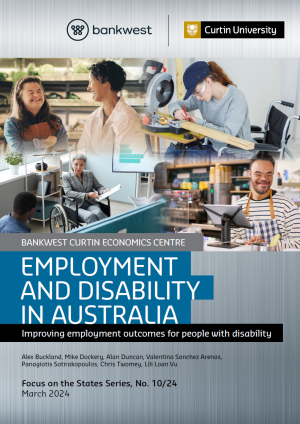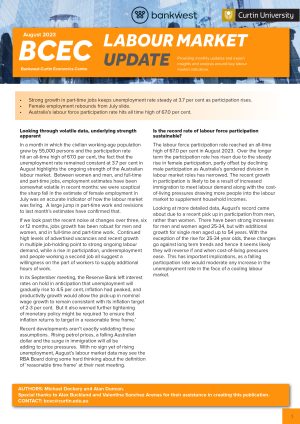BCEC Monthly Labour Market Update – August 2023
— Strong growth in part-time jobs keeps unemployment rate steady at 3.7 per cent as participation rises. —
— Female employment rebounds from July slide. —
— Australia’s labour force participation rate hits all time high of 67.0 per cent. —
Looking through volatile data, underlying strength apparent
In a month in which the civilian working-age population grew by 55,000 persons and the participation rate hit an all-time high of 67.0 per cent, the fact that the unemployment rate remained constant at 3.7 per cent in August highlights the ongoing strength of the Australian labour market.
Between women and men, and full-time and part-time jobs, employment estimates have been somewhat volatile in recent months: we were sceptical the sharp fall in the estimate of female employment in July was an accurate indicator of how the labour market was faring. A large jump in part-time work and revisions to last month’s estimates have confirmed that.
If we look past the recent noise at changes over three, six or 12 months, jobs growth has been robust for men and women, and in full-time and part-time work. Continued high levels of advertised vacancies and recent growth in multiple job-holding point to strong ongoing labour demand, while a rise in participation, underemployment and people working a second job all suggest a willingness on the part of workers to supply additional hours of work.
In its September meeting, the Reserve Bank left interest rates on hold in anticipation that unemployment will gradually rise to 4.5 per cent, inflation had peaked, and productivity growth would allow the pick-up in nominal wage growth to remain consistent with its inflation target of 2-3 per cent. But it also warned further tightening
of monetary policy might be required ‘to ensure that inflation returns to target in a reasonable time frame.’
Recent developments aren’t exactly validating those assumptions. Rising petrol prices, a falling Australian dollar and the surge in immigration will all be adding to price pressures. With no sign yet of rising unemployment, August’s labour market data may see the RBA Board doing some hard thinking about the definition of ‘reasonable time frame’ at their next meeting.
Is the record rate of labour force participation sustainable?
The labour force participation rate reached an all-time high of 67.0 per cent in August 2023.
Over the longer term the participation rate has risen due to the steady rise in female participation, partly offset by declining male participation as Australia’s gendered division in labour market roles has narrowed.
The recent growth in participation is likely to be a result of increased immigration to meet labour demand along with the cost-of-living pressures drawing more people into the labour market to supplement household incomes.
Looking at more detailed data, August’s record came about due to a recent pick up in participation from men, rather than women.
There have been strong increases for men and women aged 25-34, but with additional growth for single men aged up to 54 years. With the exception of the rise for 25-34 year olds, these changes go against long term trends and hence it seems likely they will reverse if and when cost-of-living pressures ease.
This has important implications, as a falling participation rate would moderate any increase in the unemployment rate in the face of a cooling labour market.




